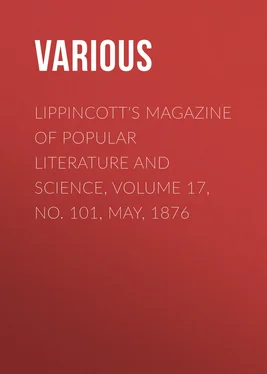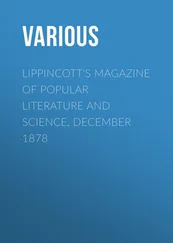Various - Lippincott's Magazine of Popular Literature and Science, Volume 17, No. 101, May, 1876
Здесь есть возможность читать онлайн «Various - Lippincott's Magazine of Popular Literature and Science, Volume 17, No. 101, May, 1876» — ознакомительный отрывок электронной книги совершенно бесплатно, а после прочтения отрывка купить полную версию. В некоторых случаях можно слушать аудио, скачать через торрент в формате fb2 и присутствует краткое содержание. Издательство: Иностранный паблик, Жанр: foreign_antique, periodic, foreign_edu, на английском языке. Описание произведения, (предисловие) а так же отзывы посетителей доступны на портале библиотеки ЛибКат.
- Название:Lippincott's Magazine of Popular Literature and Science, Volume 17, No. 101, May, 1876
- Автор:
- Издательство:Иностранный паблик
- Жанр:
- Год:неизвестен
- ISBN:нет данных
- Рейтинг книги:3 / 5. Голосов: 1
-
Избранное:Добавить в избранное
- Отзывы:
-
Ваша оценка:
- 60
- 1
- 2
- 3
- 4
- 5
Lippincott's Magazine of Popular Literature and Science, Volume 17, No. 101, May, 1876: краткое содержание, описание и аннотация
Предлагаем к чтению аннотацию, описание, краткое содержание или предисловие (зависит от того, что написал сам автор книги «Lippincott's Magazine of Popular Literature and Science, Volume 17, No. 101, May, 1876»). Если вы не нашли необходимую информацию о книге — напишите в комментариях, мы постараемся отыскать её.
Lippincott's Magazine of Popular Literature and Science, Volume 17, No. 101, May, 1876 — читать онлайн ознакомительный отрывок
Ниже представлен текст книги, разбитый по страницам. Система сохранения места последней прочитанной страницы, позволяет с удобством читать онлайн бесплатно книгу «Lippincott's Magazine of Popular Literature and Science, Volume 17, No. 101, May, 1876», без необходимости каждый раз заново искать на чём Вы остановились. Поставьте закладку, и сможете в любой момент перейти на страницу, на которой закончили чтение.
Интервал:
Закладка:
Prior to the middle of the twelfth century Vienna appears to have been a town of little importance. In fact, the precise time when the name Wien first occurs is in dispute. Giesebrecht discovered it in documents purporting to date from the beginning of the eleventh century, but the genuineness of the documents is doubted by most historians. The town is mentioned several times in the Nibelungenlied , and described as existing in the times of Etzel (Attila, king of the Huns). But this is undoubtedly the invention of popular fancy. The Nibelungenlied was put into its present shape between the middle and the end of the twelfth century. The poet has changed more than one feature of the original saga, has blended, not unskillfully, primitive Teutonic myth with historic personages and events of the early Middle Ages, and has interpolated sayings and traditions of his own times. The Viennese of the twelfth century sought, with pardonable vanity, to invest their town with the sacredness of antiquity. But we can scarcely allow their claims. On the contrary, we must deny all continuity between the Vindobona of the fourth and the Wien of the twelfth century. The Roman castrum disappeared, the Babenberg capital appeared, but between the two there is an unexplored gulf. Yet this incipient Vienna, although only the capital of a ducal family that had a hard fight at times for existence, holds an honorable position in the annals of German literature. The Babenberg dukes were generous patrons of the Muses. Their court was frequented by minnesingers and knights-errant. Their praises were sung by Walther von der Vogelweide, Ulrich von Lichtenstein and others. Walther, in his ode to Duke Leopold, has almost anticipated Shakespeare, when he sings—
His largess, like the gentle rain,
Refresheth land and folk.
Vienna and the memorable Wartburg in Thuringia were the acknowledged centres of taste and good breeding. They were the courts of last resort in all questions of style, grammar and versification.
It will not be necessary to follow the growth of Vienna in detail during the last six hundred years. The dangers to which the city was exposed from time to time were formidable. They came chiefly from two quarters—from Bohemia and from Hungaro-Turkey. Charles IV. and Wenzel favored the Bohemians at the expense of the Germans, and preferred Prague to Vienna as a residence. The Czechish nation increased rapidly in wealth and culture until, having embraced the doctrines of Huss, it felt itself strong enough to assert a quasi-independence. The Hussite wars which ensued in the fifteenth century ended in the downfall of Bohemia. But the Austrian duchies, and even Bavaria and Saxony, did not escape without cruel injuries. More than once the fanatic Taborites laid the land waste up to the gates of Vienna. The Reformation, a century later, did not take deep root in Austria. At best it was only tolerated, and the Jesuit reaction, encouraged by Rudolph II. and Matthias, made short work of it. The Thirty Years' war gave Ferdinand II. an opportunity of restoring Bohemia to the Roman Catholic communion. The victory of the White Hill (1620) prostrated Bohemia at his feet: the Hussite preachers were executed or banished, the estates of the nobility who had taken part in the rebellion were confiscated, and the Catholic worship reinstated by force of arms. So thoroughly was the work done that Bohemia at the present day is, next to the Tyrol, the stronghold of Catholicism. But Ferdinand's success, complete to outward appearance, was in reality a blunder. The Czechish and the German nationalities were permanently estranged, and the former, despoiled, degraded, incapacitated for joining the work of reform upon which the latter has finally entered, now constitutes an obstacle to progress. While the Austrian duchies are at present extremely liberal in their religious and political tendencies, Bohemia and Polish Galicia are confederated with the Tyrol in opposing every measure that savors of liberalism. Bohemia has been surnamed the Ireland of the Austrian crown.
The union of Hungary with the house of Habsburg has always been personal rather than constitutional. The Hungarians claimed independence in all municipal and purely administrative matters. Moreover, during the Thirty Years' war, and even later, a large portion of the land was in possession of the Turks and their allies, the Transylvanians, with whom the Hungarians were in sympathy. The first great siege of Vienna by the Turks was in 1529—the last, and by far the most formidable, in 1683. The city escaped only through the timely assistance of the Poles under Sobieski. Ten years later the tide had changed. The Austrian armies, led by Prince Eugene, defeated the Turks in a succession of decisive battles, and put an end for ever to danger from that quarter. Hungary and Transylvania became permanent Austrian possessions.
Amid such alternations of fortune the growth of Vienna was necessarily slow. In 1714, after six centuries of existence, its population amounted to only 130,000. The city retained all the characteristics of a fortress and frontier-post. The old part, or core, now called the "inner town," was a compact body of houses surrounded by massive fortification-walls and a deep moat. Outside of this was a rayon or clear space six hundred feet in width, separating the city from the suburbs. These suburbs, Leopoldstadt, Mariahilf, etc., now incorporated with the inner city in one municipal government, were then small detached villages. From time to time the rayon was encroached upon by enterprising builders, with the connivance of the emperor or the garrison commander. The disastrous wars with France at the end of the last century and beginning of the present were in reality a gain to Vienna. Napoleon's bombardment and capture of the city in 1809, before the battle of Wagram, demonstrated conclusively that the fortifications were unable to withstand modern artillery. Accordingly, after the general European peace had been established by the Congress of Vienna, the city was declared officially by the emperor to be no longer a fortification. But the walls and ditch, so far as they had not been injured by the French, were still suffered to remain: they were substantially intact as late as 1848, and were strong enough to enable the revolutionists who had possession of the city to hold it for forty-eight hours against the army of Prince Windischgrätz.
The final reconstruction of the city was not begun in earnest until 1857, and occupied ten years or more. The walls were leveled to the ground, the moat was filled in, a broad girdle-street (the Ringstrasse) laid out to encircle the inner city, and the adjacent ground on either side was converted into building-lots. In this brief space of time Vienna was changed from a quasi-mediæval town to a modern capital of the most pronounced type. The Ringstrasse became a promenade like that of the old Paris boulevards, but broader, grander and lined with palatial edifices no whit inferior to the French. The metamorphosis is so startling that a tourist revisiting the city after an absence of twenty years would have difficulty in persuading himself that he was indeed in the residence of Maria Theresa, Joseph II. and Metternich. No American city can exhibit a like change in the same time. Our cities, although expanding incessantly, have preserved their original features. Even new Chicago, springing from the ashes of the old, has not departed from the former ground-plan and style of building. And no American city can point to a succession of buildings like the Franz Joseph Barracks, the Cur Salon with its charming park, the Grand Hôtel and the Hôtel Impérial, the Opera-house, the Votive Church, the new Stock Exchange, and the Rudolf Barracks. When the projected House of Deputies, the City Hall, and the University building are completed, the Ring street will deserve to stand by the side of the Rue de Rivoli and the Champs Élysées. The quondam suburbs ( Vorstädte ), eight in number, are now one with the city proper. Encircling them is the mur d' octroi , or barrier where municipal tolls are levied upon articles of food and drink. Outside of this barrier, again, are the suburbs of the future, the Vororte , such as Favoriten, Fünfhaus, Hernals, etc. The growth of the population is rapid and steady. In 1714 it was 130,000, in 1772 only 193,000. A century later, in 1869, it had risen to 811,000 (including the Vororte); at the present day it can scarcely fall short of 1,000,000.
Читать дальшеИнтервал:
Закладка:
Похожие книги на «Lippincott's Magazine of Popular Literature and Science, Volume 17, No. 101, May, 1876»
Представляем Вашему вниманию похожие книги на «Lippincott's Magazine of Popular Literature and Science, Volume 17, No. 101, May, 1876» списком для выбора. Мы отобрали схожую по названию и смыслу литературу в надежде предоставить читателям больше вариантов отыскать новые, интересные, ещё непрочитанные произведения.
Обсуждение, отзывы о книге «Lippincott's Magazine of Popular Literature and Science, Volume 17, No. 101, May, 1876» и просто собственные мнения читателей. Оставьте ваши комментарии, напишите, что Вы думаете о произведении, его смысле или главных героях. Укажите что конкретно понравилось, а что нет, и почему Вы так считаете.












